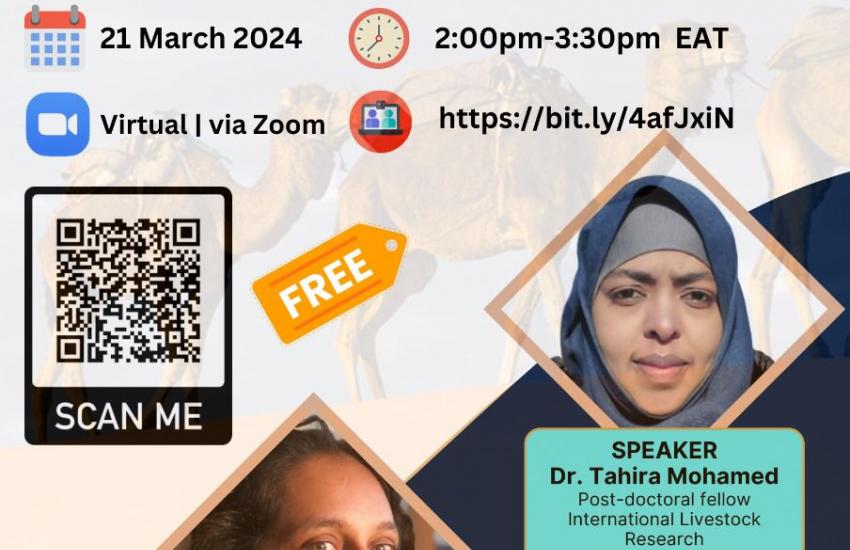IDS holds a successful seminar on “The Moral Economy of Camel Milk Marketing”
The Institute for Development Studies on Thursday 21st March 2024 held an online seminar themed, “The Moral Economy of Camel Milk Marketing”.
The speaker was Dr. Tahira Mohamed, who is a Post-doctoral fellow at the International Livestock Research Institute (ILRI), Nairobi. She examines the nexus between development programmes and humanitarian support, exploring the institutional barriers for linking development-humanitarian in preventing food crisis among the pastoralists and agro-pastoralists in the Horn of Africa.
Dr. Mohamed did her PhD at the University of Sussex, Institute of Development Studies, United Kingdom. Her thesis explored: The role of the moral economy in response to uncertainty among the Borana pastoralists of Northern Kenya, Isiolo County.
The discussant was Dr. Natasha Maru, a researcher and policy consultant on pastoralist issues. On the one hand, she works with international organisations to support pastoralist voices in global advocacy spaces, on the other hand, she researches and writes on pastoralism mainly in western India. She is interested in resource politics, food systems, the commons, mobility, and living life in technicolour.
Dr. Maru holds a PhD in Development Studies from the Institute of Development Studies (IDS), University of Sussex, UK, and an MPhil in Development Studies from the University of Oxford.
The session was moderated by Mr. John Njoka of IDS.
The abstract of Dr. Mohamed’s paper reads as follows: Camels play an increasingly significant role in restructuring livelihoods in northern Kenya’s arid regions. The marketing of camel milk (CMM) is influenced by two primary factors: expanding urban demand and the proliferation of market infrastructure and motorcycle transport. On the one hand, CMM is driven by the need to satisfy the growing urban market, while on the other hand, it is driven by the need for local pastoralists to diversify and expand their economies. The complex network of relationships, contracts, and networks being established locally makes the CMM feasible. Cooperatives led by women are at the center of this network, facilitating the daily transport of fresh raw camel milk from the arid regions of northern Kenya to the bustling markets of Nairobi.
Our analysis of the growing importance of the camel economy in the region reveals the evolution of camel milk production and marketing in the Isiolo-centric channels. Our perspective is informed by the moral economy and draws on other perspectives that address social and cultural transformations in dryland societies. We utilized a mixed-methods approach, integrating existing datasets of CMM enterprises with extensive fieldwork and qualitative data collection from the agents involved. Our investigation uncovers how CMM networks are embedded within the local social, cultural, and political context and how these networks strengthen rural-urban connections, supporting the livelihoods of marginalized groups.
Dr. Maru shared the India experience, and her abstract reads as below:
While Tahira presents the case of CMM in Kenya, I draw from my own experiences of CMM in western India, especially as it is tied to grazing access. In India, camel milk is newly being marketed and has not developed the kind of consumer base to keep the market going. I will present the example of camel keeping either side of the Gulf of Kachchh in western India where a unique breed of swimming camels, the Kharai camel, is kept. This camel is fed on mangrove vegetation, and while both sides see having industrialization – with India’s biggest port on one side, and biggest petroleum company on the other – the politics of resource access and milk marketing are shaping two different stories. On one side of the Gulf support from a local organization has linked pastoralists to the formal milk chain and camel milk marketing, while on the side, this link is not established. At the same time access to mangroves is restricted, making it difficult to keep camels, and therefore making market linkages even more precarious. There is much to learn from the Kenya example, and examining it from a context where the same systems do not exist will be interesting.
The seminar was well attended with over 80 participants at one point, and some questions and comments that were raised include:
Marie-Luise: I came across the concept of “buusaa gonofaa” as an example of solidarity in the Borana community of Southern Ethiopia. Is “buusaa gonofaa” an example of moral economy too – or if not, what is the difference? Thank you!
Jacob: How does “fair terms of trade” concept relate to moral economy?
Paul Kamau: How is the governance structure in this camel milk value chain? Who are the key actors – producers or buyers? What proportion of milk consumed in Kenya or Isiolo is from camel?
Stacy: How do individual herders ensure the quality of milk, especially during drought season, which has been a challenge to agricultural products hence the variation of prices locally and internationally?
Wendy: What are we hearing from private sector actors (especially financial services providers as to their interest in supporting producers or off-takers in this value chain? In the past they were quite risk averse and tended to avoid but are we seeing any changes in investment appetite?


